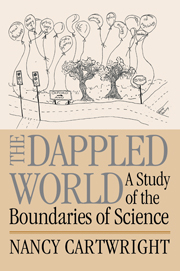Book contents
- Frontmatter
- Contents
- Acknowledgements
- Introduction
- Part I Where do laws of nature come from?
- Part II Laws and theier limits
- Part III The boundaries of quantum and classical physics and the territories they share
- 8 How bridge principles set the domain of quantum theory
- 9 How quantum and classical theories relate
- Bibliography
- Index
9 - How quantum and classical theories relate
Published online by Cambridge University Press: 05 June 2012
- Frontmatter
- Contents
- Acknowledgements
- Introduction
- Part I Where do laws of nature come from?
- Part II Laws and theier limits
- Part III The boundaries of quantum and classical physics and the territories they share
- 8 How bridge principles set the domain of quantum theory
- 9 How quantum and classical theories relate
- Bibliography
- Index
Summary
Setting the problem
Consider a number of widely discussed topics in the philosophy of quantum mechanics: the measurement problem, the ever-expanding wave packet (Einstein's bed, which he feared would eventually fill his room), the possibility of state preparation, wave-particle duality. These problems are all reflections of the same basic phenomenon: for one and the same kind of system (say an electron) in order to describe adequately how it behaves in one context (if, for instance, we put a photographic plate in its path), we assign one quantum state to it at a particular time (in this case an eigenstate of position, or at least a state narrowly focused in position-space). But in order to represent the statistical results that would obtain in some different setting (imagine instead that we set a diffraction grating in its path followed by a detection screen) we assign a quite different state to it. The state in the latter case is generally a superposition of those states that describe the behaviour that might have been exhibited in the former setting. We can call this problem the problem of superposition.
There are broadly two strategies for solving the problem of superposition. The first is the strategy of reduction. When the system enters a setting in which its behaviour is correctly described by some component of the superposition, the state of the system physically changes from the superposition to one of the required components. This strategy faces three challenges.
- Type
- Chapter
- Information
- The Dappled WorldA Study of the Boundaries of Science, pp. 211 - 233Publisher: Cambridge University PressPrint publication year: 1999



